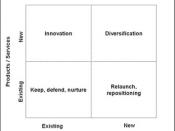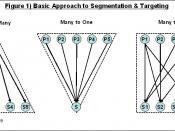Marketing Study Notes
Target Market - to whom will you target the product.
Developing Starategic Marketing Plan
- identify, evaluate & select the market
- when market is selected, develop & implement a Marketing Program designed to target choosen market.
Market - people with willingness to purchase and authority to buy.
Types of Markets:
CONSUMERR GOODS - products & services purchased by consumer for personal use.
INDUSTRIAL GOODS - products purchased to be used for production of other goods or for resale.
marketing of Industrial Goods also called - "Business to Business Marketing".
the key to proper classification of goods lies in the purchaser & in the reasons for buying the good.
Market Segmentation - grouping people according to their similarity in one or more dimensions related to a particular product category.
Market Segmantation:
age, gender, geographic location, income, population, mobility, etc. are vital for marketing strategy.
5 basis for segmenting consumer markets:
1. Demographic Segmentation
2. Geographic Segmentation
3. Psychographic Segmentation
4. Benefit Segmentation
5. Usage Rate
GEOGRAPHIC SEGMENTATION - dividing market into homogeneous groups based on population location. (used for ages)
DEMOGRAPHIC SEGMENTATION - dividing market on characteristics such as age, gender, income. (easiest)
PSYCHOGRAPHIC SEGMENTATION - to identify market segments it uses behavioural profiles developed from analyses of the activities, opinions, interests, and lifestyles of consumers.
BENEFIT SEGMENTATION - depends on advanced marketing research techniques that focus on benefits the consumer expects to derive from a product.
USAGE RATE - divides the market by amount of product consumed, and/or brand loyalty.
Start point in market segmentation - find where your buyers are. Geographic.
(People move to bigger populated placed. Immigration impacted Canada. People are in the cities. Canada's population - urban. Toronto - Montreal - Vancouver : biggest.)
Residence location within geographic area is very important.
Climate also.
Geographic segmentation - which sales regions to enter, where sales offices located, where retail outlets are located.
Geographic segmentation is useful whendifferences in preference and purchase patterns emerge from regional lines.
DEMOGRAPHIC SEGMENTATION - age, gender, income, occupation, education, household size.
Demographic Segmentation is used for 3 reasons:
1. They are easy to identify and measure
2. They are associated with the sale of many products and services
3. They are typically referred to in describing the audiences of advertising media, so that media buyers and others can easily pinpoint the desired target market.
Many products are gender specific (razors)
Age: 45 - 65 - grown children, mortgages paid off - more disposable income. This income is used for luxury goods, new furniture, travel.
Senior-Citizen Market.
FAMILY LIFE CYCLE - the process of family formation, development, and dissolution.
Patrick Murphy & William Staples made 6 stage family life cycle.
Middle age and older with no children have more disposable income.
Segmentation by Household Size
Half of households in Canada include 1 or 2 persons, Average household size is 3 persons.
SINGLE_PERSON household emerged as important maeket segment with special title:
SSWD
Single
Separated
Widowed
Divorced.
SSWDs buy app. 25% of all passenger cars.
Segmenting by Income:
Very common method.
Income statistics are analyzed by family structure.
Families can be divided into 2 groups:
Husband-Wife Families (their income increased olmost twice compare to female lone-parent families)
Lone-Parent Families
Household expenditures can be divided into 2 categories:
1). Basic Purchases of essential hopusehold needs
2). Other Purchases - after necessities - disposable imcome.
Engel's Laws
Ernst Engel German Statistician.
( his studies of spending behaviour).
AS FAMILY INCOME INCREASES:
1). SMALER % GOES TO FOOD
2). % SPENT ON HOUSING & HOUSEHOLD OPERATIONS & CLOTHING WILL REMAIN CONSTANT.
3).% SPENT ON OTHER ITEMS WILL INCREASE.
2ND point of law is declines nowadays
3 rd true nowadays
These laws are also useful when evaluating a foreign counrty as potential target market.
Demographic Segmentation influences local distribution channels.
PSYCHOGRAPHIC SEGMENTATION
LIFESTYLE - mode of living.
Psychographics - use of psychological attributes, lifestyles, and attitudes in determining the behavioural profiles of different consumers.
Ussually developed through Market Research asking for "agree" or "disagree" statements when dealing with AIO statements.
AIO statements: ACTIVITIES, INTERESTS, OPINIONS used in developing psychographic profiles.
6 GOLDFARB SEGMENTS
day-to-day watchers - satisfied with what life offers. Early followers than leaders. Keep close eye on the world around them.
old-fashioned puritans - conservative, traditional. Not the best group for new products.
responsible survivors - Cautious group, brand-loyal, heavy TV viewers.
joiner-activists - thinkers
aggressive achievers - confident, success oriented, want to be leaders, love status goods.
disinterested self-indulgents' - Tv viewing . Music taste more conservative, pop-rock, oldies.
ENVIRONICS SEGMENTS
They divide population ointo 3 main age groups.
Elders (50+)
Boomers (30-40)
Generation X (15-29)
Each age group is subdivides into psychograpgic segments;
ELDERS:
Rational Traditionalists (stability & security)
Extroverted Traditionalists (Religiosity & Family)
Cosmopolitan Modernists (Global World-View, Respect for Education, Desire for innovation)
BOOMERS
Autonomous Rebels (Freedom, Individuality, Education)
Anxious Communitarians (Family, community, duty, respect)
Connected Enthusiasts (family, hedonism, gratification)
Disengaged Darwinists (Nostalgic about past)
GENERATION X
Aimless Dependents (independence)
Thrill-Seeking Materialists (Money, recognition, respect, admiration.)
New Aquarians (Ecology, Hedonism)
Autonomous Postmaterialists (Freedom, Respect for Human Rights)
Social Hedonists (aesthetics, hedonism, sexual permissiveness, gratification)


